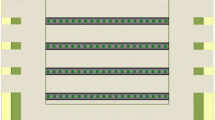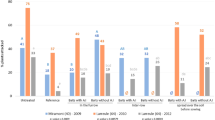Abstract
The polyphagous larvae of click beetles (Coleoptera: Elateridae) are major pests of spring wheat in Montana, USA. Presently available insecticides are unable to provide control over wireworm populations, and the use of natural enemies has not been successful under field conditions. In this study, we examined the effect of seven trap crops: pea, lentil, canola, corn, durum, barley, and wheat, for their attractiveness to wireworms compared to spring wheat. Experimental plots were located in two commercial grain fields in Valier and Ledger, Montana, USA and the trials took place from May to August in 2015 and 2016. Wheat plants damaged by wireworms were recorded and their relative locations in wheat rows and adjacent trap crop rows within a plot were determined using destructive soil samples. In 2016, variable row spacing (0.25, 0.5, 0.75, and 1 m) between the trap crops (pea and lentil) and wheat was assessed. Shade house bioassays were conducted using potted pea, lentil, and wheat plants to support field trial results. Limonius californicus larvae, released at the center of each pot were sampled 4 and 10 days after sowing. Wheat intercropped with pea and lentil had significantly fewer damaged wheat plants. Wireworm numbers were lower in wheat intercropped with pea compared to the control for both locations and years. Shade house results corresponded with field results, with more wireworms collected from pea and lentil than wheat. In the spacing trials, wheat plant counts were also significantly higher when paired with pea and lentil, particularly at 0.5 m spacing. Regardless of inter-row spacing, significantly fewer wireworms were associated with wheat when intercropped with pea and lentil trap crops.









Similar content being viewed by others
References
Barsics F, Latine F, Gfeller A, Laloux M, Lognay G, Wathelet JP, Haubruge E, Verheggen FJ (2012) Do root-emitted volatile organic compounds attract wireworm. Commun Agric Appl Biol Sci 77:561–565
Barsics F, Haubruge E, Verheggen FJ (2013) Wireworms’ management: an overview of the existing methods, with particular regards to Agriotes spp. (Coleoptera: Elateridae). Insects 4:117–152
Barsics F, Delory BM, Delaplace P, Francis F, Fauconnier ML, Haubruge E, Verheggen FJ (2016) Foraging wireworms are attracted to root-produced volatile aldehydes. J Pest Sci 90:69–76
Bourassa C, Vincent C, Lomer CJ, Borgemeister C, Mauffette Y (2001) Effects of entomopathogenic hyphomycetes against the larger grain borer, Prostephanus truncatus (Horn) (Coleoptera: Bostrichidae), and its predator, Teretriosoma nigrescens Lewis (Coleoptera: Histeridae). J Invertebr Pathol 77:75–77
Brandl MA, Schumann M, Przyklenk M, Patel A, Vidal S (2017) Wireworm damage reduction in potatoes with an attract-and-kill strategy using Metarhizium brunneum. J Pest Sci 90:479–493
Canfield RH (1941) Application of the line interception method in sampling range vegetation. J For 39:388–394
Doane J, Lee Y, Klingler J, Westcott N (1975) The orientation response of Ctemcera destructor and other wireworms (Coleoptera: Elateridae) to germinating grain and to carbon dioxide. Can Entomol 107:1233–1252
Etzler FE (2013) Identification of economic wireworms using traditional and molecular methods. M.S. thesis dissertation, Montana State University, Bozeman, Montana
Furlan L, Bonetto C, Finotto A, Lazzeri L, Malaguti L, Patalano G, Parker W (2010) The efficacy of biofumigant meals and plants to control wireworm populations. Ind Crop Prod 31:245–254
Griffiths DC (1974) Susceptibility of plants to attack by wireworms (Agriots spp.). Ann Appl Biol 78:7–13
Hermann A, Brunner N, Hann P, Wrbka T, Kromp B (2012) Correlations between wireworm damages in potato fields and landscape structure at different scales. J Pest Sci 86:41–51
Hiltpold I, Bernklau E, Bjostad LB (2013) Nature, evolution and characterisation of rhizosphere chemical exudates affecting root herbivores. In: Johnson SN, Hiltpold I, Turlings TCJ (eds) Advances in insect physiology, vol 45. Academic, Oxford, pp 97–157
Hokkanen HMT (1991) Trap cropping in pest management. Annu Rev Entomol 36:119–138
Horton D (2007) How do wireworms find their hosts? Potato Prog VII 10:1–3
Hyslop JA (1916) Wireworms destructive to cereal and forage crops. US Dep Agric Farmers Bull 725:1–10
Jaronski ST (2010) Ecological factors in the inundative use of fungal entomopathogens. Biocontrol 55:159–185
Jedlička P, Frouz J (2007) Population dynamics of wireworms (Coleoptera, Elateridae) in arable land after abandonment. Biologia 62:103–111
Johnson PJ (2009) Classification of the Nearctic genera of Elateridae. www.sdstate.edu/ps/Severin-McDaniel/project
Johnson SN, Nielsen UN (2012) Foraging in the dark—chemically mediated host plant location by belowground insect herbivores. J Chem Ecol 38:604–614
Jonasson S (1988) Evaluation of the point intercept method for the estimation of plant biomass. Oikos 52:101–106
Kabaluk TJ, Goettel M, Vernon RS, Noronha (2001) Evaluation of Metarhizium anisopliae as a biological control for wireworms. Organic Agriculture Centre of Canada. http://www.agbio.ca/ResearchDatabase/res_biol_ctrl_wireworms.asp
Kabanov VA (1975) Uber Vorkommen und Entwicklung von Agriotes lineatus (Coleoptera, Elateridae) im europaischen Teil der UdSSR. Pedobiology 15:98–105
Keiser A, Häberli M, Stamp P (2012) Dry core appears to result from an interaction between Rhizoctonia solani and wireworm (Agriotes ssp.)—evidence from a 3-year field survey. Potato Res 55:59–67
Keller S, Schweizer C (2001) Ist das Drahtwurm-Problem ein Pilz-Problem. Agrarforschung 7:248–251
Lafrance J (1968) The seasonal movements of wireworms (Coleoptera: Elateridae) in relation to soil moisture and temperature in the organic soils of southwestern Quebec. Can Entomol 100:801–807
Landl M, Glauninger J (2011) Preliminary investigations into the use of trap crops to control Agriotes spp. (Coleoptera: Elateridae) in potato crops. J Pest Sci 86:85–90
Langenbuch R (1932) Beiträge zur Kenntnis der Biologie von Agriotes lineatus L. and Agriotes obscurus L. Z Ang Entomol 19:278–300
McCaffrey J, Williams L, Borek V, Brown P, Morra M (1995) Toxicity of ionic thiocyanate-amended soil to the wireworm Limonius californicus (Coleoptera: Elateridae). J Econ Entomol 88:793–797
Miles HW, Petherbridge RFR (1927) Investigations on the control of wireworms. Ann Appl Biol 14:359–387
Milosavljević I, Esser AD, Crowder DW (2016) Seasonal population dynamics of wireworms in wheat crops in the Pacific Northwestern United States. J Pest Sci 90:77–86
Morales-Rodriguez A, O’Neill RP, Wanner KW (2014) A survey of wireworm (Coleoptera: Elateridae) species infesting cereal crops in Montana. Pan-Pacific Entomol 90:116–125
Parker WE (1994) Evaluation of the use of food baits for detecting wireworms (Agriotes spp., Coleoptera: Elateridae) in fields intended for arable crop production. Crop Prot 13:271–276
Parker WE, Howard JJ (2001) The biology and management of wireworms (Agriotes spp.) on potato with particular reference to the UK. Agric Forest Entomol 3:85–98
Petherbridge FR (1938) Wireworms and sugar-beet. J Minist Agric Lond 45:23–70
R Development Core Team (2012) R: a language and environment for statistical computing. R Foundation for Statistical Computing, Vienna. http://www.R-project.org
Rashed A, Rogers CW, Rashidi M, Marshall JM (2017) Sugar beet wireworm Limonius californicus damage to wheat and barley: evaluations of plant damage with respect to soil media, seeding depth, and diatomaceous earth application. Arthropod-Plant Interact 11:147–154
Reddy GVP, Tangtrakulwanich K, Wu S, Miller JH, Ophus VL, Prewett J, Jaronski ST (2014) Evaluation of the effectiveness of entomopathogens for the management of wireworms (Coleoptera: Elateridae) on spring wheat. J Invertebr Pathol 120:43–49
Reddy GVP, Adhikari A, Frank A, Miller JH (2015) Evalaution of trap crops of the management of wireworms on spring wheat. Annual report. Western Triangle Agricultural Research Center, Conrad, pp 60–66
Reddy GVP, Adhikari A, Frank A, Miller JH, Prewett J (2016) Evaluation of trap crops for the management of wireowrms in spring wheat in Montana. Annual Report. Western Triangle Agricultural Research Center, Conrad, pp 110–124
Russell EJ (1936) Boden und Pflanze, Verlag von Theodor Steinkopff, Th. Steinkopff, Dresden und Leipzig
Schallhart N, Tusch M, Staudacher K, Wallinger C, Traugott M (2011) Stable isotope analysis reveals whether soil-living elaterid larvae move between agricultural crops. Soil Biol Biochem 43:1612–1614
Seal DR, Chalfant RB, Hall MR (1992) Effectiveness of different seed baits and baiting methods for wireworms (Coleoptera: Elateridae) in sweetpotato. Environ Entomol 21:957–963
Seibert CE (1993) A faunal survey of the Elateridea of Montana. Montana State University, Department of Plant Science and Plant Pathology. MSc Thesis. Bozeman
Shaw RH (1988) Climate requirement. Corn and corn improvement cornandcornimpr: 609–638
Shelton A, Badenes-Perez F (2006) Concepts and applications of trap cropping in pest management. Ann Rev Entomol 51:285–308
Staudacher K, Schallhart N, Thalinger B, Wallinger C, Juen A, Traugott M (2013) Plant diversity affects behavior of generalist root herbivores, reduces crop damage, and enhances crop yield. Ecol Appl 23:1135–1145
Svensson GP, Larsson MC, Hedin J (2004) Attraction of the larvalpredator Elater ferrugineus to the sex pheromone of its prey, Osmoderma eremita, and its implication for conservation biology. J Chem Ecol 30:353–363
Traugott M, Benefer CM, Blackshaw RP, van Herk WG, Vernon RS (2015) Biology, ecology, and control of elaterid beetles in agricultural land. Annu Rev Entomol 60:313–334
Van Herk WG, Vernon RS (2007) Morbidity and recovery of the Pacific Coast wireworm, Limonius canus, following contact with tefluthrin-treated wheat seeds. Entomol Exp Appl 125:111–117
Vernon RS, Kabaluk T, Behringer A (2000) Movement of Agriotes obscurus (Coleoptera: Elateridae) in strawberry (Rosaceae) plantings with wheat (Gramineae) as a trap crop. Can Entomol 132:231–241
Vernon RS, Van Herk WG, Clodius M, Harding C (2009) Wireworm management I: stand protection versus wireworm mortality with wheat seed treatments. J Econ Entomol 102:2126–2136
Zhang Z, Zhang X, Zhao Y, Mu W, Liu F (2017) Efficacy of insecticidal seed treatments against the wireworm Pleonomus canaliculatus Coleoptera: Elateridae) in China. Crop Prot 92:134–142
Acknowledgements
This project is supported by the Montana Wheat and Barley Committee. This material is based upon work supported by the National Institute of Food and Agriculture, U.S. Department of Agriculture, Hatch under award Accn# 1009746. We would like to thank Dr. Bob Vernon, Agriculture and Agri-Food Canada, Dr. Kevin Wanner and Dr. Mike Ivie from Montana State University, Bozeman for their valuable suggestions, and summer interns Javan Caroll and Gaby Drishinski for their assistance in the field.
Author information
Authors and Affiliations
Corresponding author
Ethics declarations
Conflict of interest
The authors declare that they have no conflict of interest.
Additional information
Handling Editor: Heikki Hokkanen.
Rights and permissions
About this article
Cite this article
Adhikari, A., Reddy, G.V.P. Evaluation of trap crops for the management of wireworms in spring wheat in Montana. Arthropod-Plant Interactions 11, 755–766 (2017). https://doi.org/10.1007/s11829-017-9533-5
Received:
Accepted:
Published:
Issue Date:
DOI: https://doi.org/10.1007/s11829-017-9533-5




